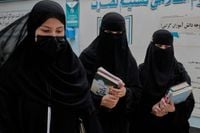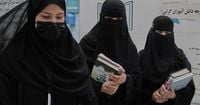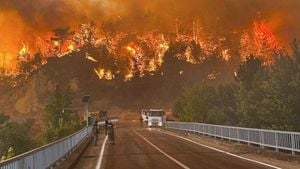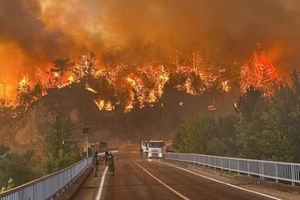In Afghanistan, a stark educational divide has emerged since the Taliban government imposed a ban on girls attending secondary schools and universities three years ago, making it the only country in the world to enforce such a restriction. This policy has forced countless girls and women to abandon their dreams of higher education and professional careers, turning instead to religious schools known as madrassas for learning.
Thirteen-year-old Nahideh embodies the profound impact of this ban. Each day after completing the highest level of schooling permitted for girls—primary education—she spends six hours working in a cemetery, collecting water from a nearby shrine to sell to mourners. Despite her exhausting routine, Nahideh harbors a dream that now seems out of reach: becoming a doctor. However, with the closure of secondary schools to girls, her educational path is limited to enrolling in a madrassa, where the curriculum centers predominantly on the Quran and Islamic teachings.
“I prefer to go to school, but I can’t, so I will go to a madrassa,” Nahideh explained, her dark brown eyes peering from beneath her black headscarf. “If I could go to school then I could learn and become a doctor. But I can’t.” Her words underscore the frustration and resignation felt by many Afghan girls caught in this educational squeeze.
The Taliban’s ban is part of a broader set of restrictions on women and girls, dictating their clothing, mobility, and social interactions. With formal secondary and higher education barred, madrassas have become the primary avenue for many to continue learning. Zahid-ur-Rehman Sahibi, director of the Tasnim Nasrat Islamic Sciences Educational Center in Kabul, noted a surge in female enrollment since schools closed. At his center, about 90% of the roughly 400 students are female, ranging in age from toddlers to seniors in their sixties. They study religious subjects such as the Quran, Islamic jurisprudence, the sayings of the Prophet Muhammad, and Arabic—the language of the Quran.
“Since the schools are closed to girls, they see this as an opportunity,” Sahibi said. “So, they come here to stay engaged in learning and studying religious sciences.” He added that even before the closures, many Afghans attended madrassas, but the interest has significantly increased because madrassas remain accessible to girls.
Official figures on madrassa enrollment are scarce, but Deputy Minister of Education Karamatullah Akhundzada revealed last September that over one million students had enrolled in madrassas in the past year alone, raising the total to more than three million. This growth reflects a shifting educational landscape where religious studies have become the default option for many, particularly females.
Among the students is 25-year-old Faiza, who enrolled at the Tasnim Nasrat center five months ago. Like Nahideh, she dreams of a career in medicine but understands that path is currently closed. “It is very good for girls and women to study at a madrassa, because … the Quran is the word of Allah, and we are Muslims,” she said. “Therefore, it is our duty to know what is in the book that Allah has revealed to us, to understand its interpretation and translation.”
Faiza holds onto a glimmer of hope that her dedication to religious studies might one day open doors to further education. “When my family sees that I am learning Quranic sciences and that I am practicing all the teachings of the Quran in my life, and they are assured of this, they will definitely allow me to continue my studies,” she said. Notably, medicine remains one of the few professional fields still open to women under the Taliban regime.
Yet, not everyone within Afghanistan or even the Taliban agrees with the strict educational limitations. In a rare display of dissent, Deputy Foreign Minister Sher Abbas Stanikzai publicly stated in January that there was no justification for denying education to girls and women. His remarks were reportedly met with disapproval from Taliban leadership, and he is now believed to have left the country. His stance highlights an internal debate about the long-term consequences of educational restrictions.
UNICEF Executive Director Catherine Russell warned in March at the start of Afghanistan’s school year that if the ban persists until 2030, over four million girls will have been denied education beyond primary school. She emphasized the devastating effects this would have on Afghanistan’s health system, economy, and future. “The consequences for these girls—and for Afghanistan—are catastrophic,” she said.
Religious education remains deeply embedded in Afghan society. Mullah Mohammed Jan Mukhtar, who runs a boys’ madrassa north of Kabul, explained that his institution opened five years ago with 35 students and has since grown to 160 boys aged 5 to 21, half of whom board at the school. The madrassa offers religious studies alongside limited classes in English and math. He also oversees an affiliated girls’ madrassa with 90 students.
“Learning the Holy Quran is the foundation of all other sciences, whether it’s medicine, engineering, or other fields of knowledge,” Mukhtar said. “If someone first learns the Quran, they will then be able to learn these other sciences much better.” He advocates for more madrassas for women, emphasizing that understanding religious verdicts helps women comprehend their familial rights and responsibilities.
However, Sahibi, the director of the Tasnim Nasrat center, argues for a more balanced approach. “In my opinion, it is very important for a sister or a woman to learn both religious sciences and other subjects, because modern knowledge is also an important part of society,” he said. “Islam also recommends that modern sciences should be learned because they are necessary, and religious sciences are important alongside them. Both should be learned simultaneously.”
For Nahideh and many girls like her, the future remains uncertain. Their ambitions are constrained by policy, yet their determination to learn persists. As Afghanistan grapples with these educational challenges, the world watches closely, aware that the choices made today will shape the lives of millions of Afghan girls and the nation’s destiny for decades to come.





